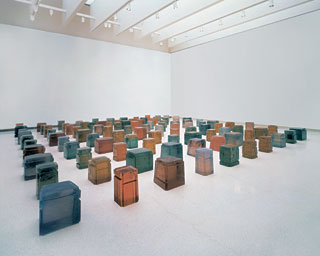|
| |
 |
|

|

Untitled (One Hundred Spaces), 1995. Resin, 100 units; overall dimensions variable. Courtesy Anthony d'Offay Gallery, London.
|

Rachel Whiteread's casts of domestic and architectural voids using plaster, concrete, rubber, and polyester resins create tangible "memories" of normally unseen spaces. In a strange, sculptural inversion, what is invisible becomes visible and what is inside becomes outside. Whiteread's work is firmly rooted in the reductive sensibility of 1960s Minimalism, but its clear connection to the empirical world expands well beyond the detached abstraction of the previous movement. Her evocations of familiar domestic spaces are often haunting if not uncanny. For example, in Ether (1990), the plaster cast of the space around a Victorian bathtub creates a coffinlike form, which, in turn, alludes to the practice of casting death masks.
Other works by Whiteread, like the multicomponent Untitled (One Hundred Spaces), are lyrical in the simplicity of their forms and their poetic rendering of space. An installation of 100 polyester resin cubes cast from the voids under 100 different chairs, the sculpture follows the precedent of Bruce Nauman, who cast the space under a chair in 1965 (a concept he said he premised on Willem de Kooning's advice to render a chair by depicting the space between its rungs). Whiteread's crystallizations of negative space are here amplified in number and expanded in meaning. Untitled (One Hundred Spaces) constitutes a field, a rainbow of like forms, which requires careful perceptual analysis to be fully appreciated. A grid of unique, semitranslucent units—subtly colored in hues of blue, pink, green, and orange—the sculpture oscillates between abstraction and reference. It shifts from being an accumulation of mute cubic forms to a shimmering index of everyday life.
|
|